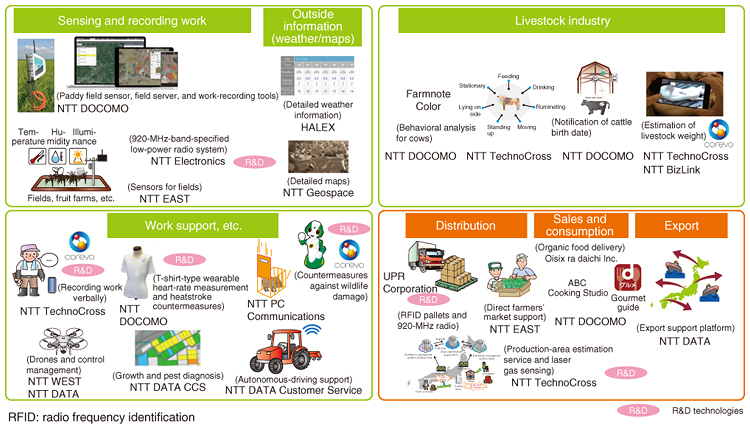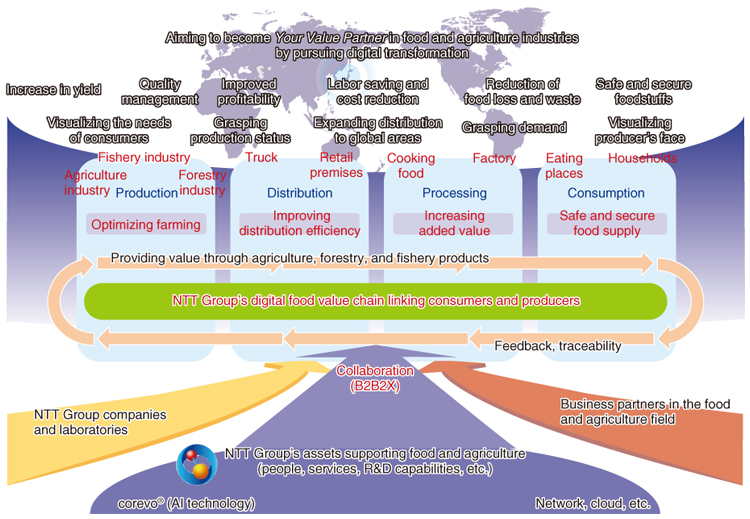 |
|||||||||||||
|
|
|||||||||||||
|
Feature Articles: New Value Creation through Collaboration with B2B2X Partners Vol. 17, No. 1, pp. 14–19, Jan. 2019. https://doi.org/10.53829/ntr201901fa4 B2B2X Collaboration in the Primary Industry Sector: Agriculture, Forestry, and FisheriesAbstractPrimary industries in Japan such as agriculture presently face problems such as a declining working population, the aging population, and a decreasing area of agricultural land. Meanwhile, the world is said to be facing a global food crisis due to the future population explosion. Information and communication technology (ICT) is attracting a lot of attention as a way to contribute to solving these domestic and international challenges. The NTT Group is actively engaged in the primary industries by utilizing the ICT that we have developed in the telecommunications business. In this article, specific efforts and future directions of the NTT Group and partners in the primary industry sector are introduced. Keywords: primary industry, food value chain, glocal 1. IntroductionIn the Japanese agricultural industry, the working population has declined and continues to age. Specifically, the working population has decreased by nearly 60% in the last 30 years, and the proportion of employees aged 65 or over presently exceeds 60%. The number of new people working in agriculture has also not significantly increased due to the instability of incomes caused by fluctuations in yield and quality (which depend on the weather) and uncertainties such as natural disasters and damage caused by wild animals. A similar trend applies in the fishery and forestry industries. On top of that, the amount of agricultural land is decreasing. The area of agricultural land in Japan, which peaked at 6 million hectares in 1965, has since decreased to about 4.5 million hectares, and the amount of cultivated land that is abandoned continues to increase year by year [1]. As a result, the area of land per management entity in Japan is about 20 to 80 times less than that of Europe and the USA. Concerns have arisen that on a global scale, the population explosion will result in a battle for food and water. Accordingly, it will be necessary in the future to increase the number of workers employed from the younger generation, enlarge the scale of agriculture, and dramatically improve agricultural productivity, while taking the global market into account in order to enable Japan’s agriculture to flourish. Meanwhile, some bright signs are appearing such as an increase in the number of companies involved in production in the primary industries and an increase in agricultural exports. At the Japanese Government’s Council on Investments for the Future, the agriculture, forestry, and fishery industries were touted as targets for reform to become part of Society 5.0 and the data-driven society, and becoming the world leader in smart agriculture was set as a top priority. 2. Efforts of NTT Group regarding agriculture × ICTThe NTT Group has also positioned agriculture as a priority area, and the NTT Research and Development Planning Department is serving as the coordinator for this effort. It has established a group-wide project called the Agriculture Working Group. This working group is conducting a wide range of studies on, for example, overall strategy, business, services, and research and development (R&D) in collaboration with major operating companies such as NTT EAST, NTT WEST, NTT DOCOMO, and NTT DATA as well as with about 30 NTT Group companies with outstanding services and research laboratories with advanced technology. Two of the group companies participating include NTT Geospace, which handles essential map information for agriculture, and HALEX Corporation, which handles weather information. We are also expanding our efforts to the fishery and forestry industries. We are utilizing the nationwide communications infrastructure and assets of group companies, network services, and artificial intelligence (AI) technology called corevo® to provide customers with technologies and solutions for the primary industries (Fig. 1). By combining these elements, for example, we can treat some areas of agricultural land—which is predicted to be large-scale and scattered in various areas—as one virtual farm, and we can centrally manage data concerning the environment and soil as well as growth conditions collected by deployed sensors and secure networks, and then analyze that data with AI.
We can use the results of the analysis to create an optimum cultivation plan for each product in question. Farm work can then be carried out efficiently according to that plan, while agricultural machines, robots, and drones work in cooperation. Furthermore, we aim to create a mechanism for solving problems including stabilizing income by, for example, visualizing the process from distribution to sales and consumption, import, and export, and producing saleable crops according to plans, based on demand. 3. Collaborations with partnersSince the NTT Group is not directly engaged in production activities such as agriculture, it lacks expert knowledge and know-how in that field. Accordingly, in line with NTT’s B2B2X (business-to-business-to-X) business model, we are promoting strategic collaborations with various partners in industry, government, and academia. For example, we are working with Kubota Corporation, a manufacturer of agricultural equipment, to create information and communication technology (ICT) innovation in the field of agriculture and water-environment infrastructure. Specifically, we are making efforts to save labor—by implementing advanced operations of water-environmental equipment and smart agriculture in order to save labor and improve the precision of agricultural work—and create services that lead to safe, secure, and sustainable infrastructure (Fig. 2).
By utilizing paddy-field sensors, an energy-saving wide-area wireless service, and a 1-km-mesh weather forecast service, we are building a mechanism to gather and visualize information collected from farm land, agricultural machinery, water-supply- and sewage-related equipment, and other places (Step 1 in Fig. 2). This mechanism is used to collect and accumulate information in the company’s farming support system called Kubota Smart-Agri System (KSAS) and in the water-environment support system called Kubota Smart Infrastructure System (KSIS), where it is analyzed by NTT’s corevo AI technology (Step 2). We are experimentally verifying a system we constructed to achieve more efficient monitoring and improved accuracy (Fig. 3). For example, by using multidimensional mixture data analysis technology developed by NTT Service Evolution Laboratories, we can efficiently extract meaningful lateral features from various kinds of data related to rice production, for example, farm temperature and humidity and the amount of solar radiation, and then forecast conditions and optimum harvest times for high-yield production of good-tasting rice.
Alternatively, to monitor the KUBOTA Submerged Membrane Unit (SMU)*1 installed in private wastewater treatment facilities, we are using anomaly detection technology developed by NTT Software Innovation Center and the open-source machine-learning processing base called Jubatus*2 [2] to analyze data such as pressure levels of submerged membranes and operating information. Such information was monitored by humans in the past but is now monitored automatically. We are also working with the JA (Japan Agricultural Cooperatives) Group on initiatives in the area of livestock and farming. For example, the National Federation of Agricultural Cooperatives Associations (ZEN-NOH) is using a system called Mobile Gyuonkei (namely, attaching sensors to cows about to give birth to precisely measure their body temperature). This helps to ensure calving proceeds safely and without accidents and protects the interests of livestock farmers. Additionally, 1-km-mesh weather information is sent to a membership information service for producers and the JA Group called APPINES/AgriInfo. The information includes data on weather, temperature, humidity, rainfall, wind direction, and wind speed and is provided at 30-minute update intervals. Such extremely up-to-date and detailed meteorological information contributes to improving agricultural productivity. Furthermore, NTT and eight other NTT Group companies are participating in the Agricultural Data Collaboration Platform Council (WAGRI)*3 [3], in which more than 200 organizations from industry, government, and academia participate. We are utilizing various open systems and data possessed by WAGRI and also providing to WAGRI speech recognition technology equipped with a state-of-the-art speech recognition engine developed by NTT Media Intelligence Laboratories as well as weather and map services of the NTT Group in order to pursue digital transformation in Japan’s agriculture industry. Another new initiative is being implemented in the fisheries field. For example, in cooperation with regional fishery cooperatives, we are helping oyster farmers determine the optimum timing of their work by understanding the state of the ocean. This involves measuring the momentarily changing seawater temperature via a sensing network that can measure sea water temperature over a wide range. Moreover, we are helping to implement measures against the poaching of fish, which has been increasing in recent years, by collaborating with Mitsuiwa Corporation, which is proposing deterrence by drone monitoring, and advancing proposals to multiple fishery cooperatives. In particular, we have confirmed that by analyzing captured images and detecting and reporting poachers using image recognition AI called Deeptector®, we can greatly reduce the labor and cost burdens of conventional monitoring vessels and monitoring personnel and deter the poaching of fish (Fig. 4).
4. Future developmentUntil now, the NTT Group has focused on the agricultural value chain by working on production in farming. In the future, we will expand our efforts to the entire farming field, including distribution, processing, sales, and consumption. For example, we aim to develop a mechanism called the digital food value chain (which connects producers and customers with digital data) to promote market-in agriculture (which produces goods according to customers’ requests). This mechanism will achieve planned and stable production as well as stable procurement, and enable concerned parties involved in farming to make profits without waste. Moreover, we will expand our efforts not only in Japan but also in a so-called glocal (global + local) manner. We are tackling agricultural problems on a global scale in ways such as expanding the digital farming system organized in Japan (local) to overseas production and utilizing blockchain and traceability technology for safe and secure importation of agricultural products produced outside Japan (global). Furthermore, we will promote prompt initiatives targeting the fishery and forestry industries through cooperation with the necessary partners. Aiming to become a value partner, in which the NTT Group is selected as a partner, we will continue to contribute to the sustainable development of primary industries with a global perspective (Fig. 5).
References
|
|||||||||||||






